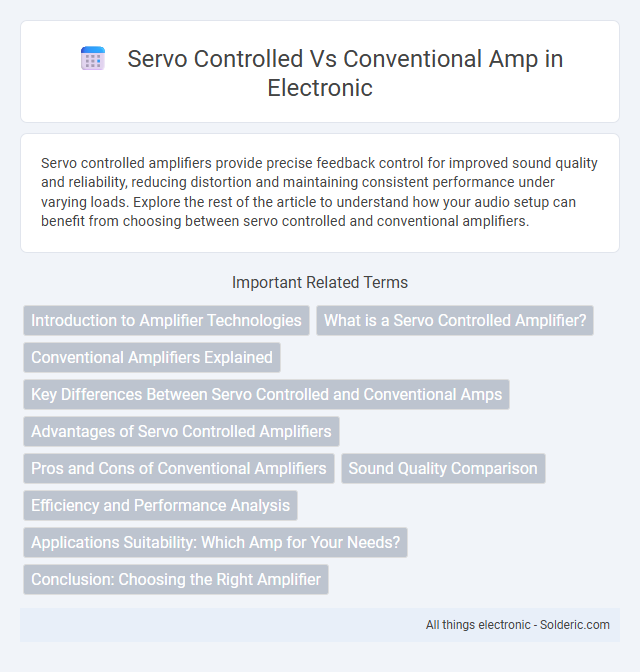Servo controlled amplifiers provide precise feedback control for improved sound quality and reliability, reducing distortion and maintaining consistent performance under varying loads. Explore the rest of the article to understand how your audio setup can benefit from choosing between servo controlled and conventional amplifiers.
Comparison Table
| Feature | Servo Controlled Amplifier | Conventional Amplifier |
|---|---|---|
| Operation | Uses feedback loop for automatic distortion correction | Fixed design with manual adjustment |
| Distortion | Low distortion due to servo correction | Higher distortion, depends on design quality |
| Frequency Response | Extended and more linear response | Limited and non-linear response |
| Cost | Higher due to complex circuitry | Generally lower and simpler |
| Maintenance | Requires precise calibration | Less complex to maintain |
| Application | High-precision audio and measurement systems | General purpose audio amplification |
Introduction to Amplifier Technologies
Servo-controlled amplifiers enhance audio fidelity by automatically adjusting the output to minimize distortion and maintain consistent signal levels, ensuring precise sound reproduction. In contrast, conventional amplifiers rely on fixed gain settings and manual adjustments, which may introduce signal inaccuracies and limit dynamic range. Your choice between the two depends on the priority for sound accuracy and real-time correction capabilities in amplifier performance.
What is a Servo Controlled Amplifier?
A Servo Controlled Amplifier is an advanced audio amplifier that uses a feedback mechanism to continuously monitor and adjust its output signal, ensuring minimal distortion and enhanced sound fidelity. Unlike Conventional Amplifiers, which rely on fixed gain settings and may introduce signal inaccuracies, servo-controlled designs actively correct deviations by comparing the output to the input signal. This technology results in improved linearity, reduced noise, and superior audio performance, making it ideal for high-fidelity audio applications and precision sound reproduction.
Conventional Amplifiers Explained
Conventional amplifiers use a fixed bias and rely on feedback loops to maintain signal fidelity, often resulting in increased distortion and reduced efficiency at high power levels. Unlike servo-controlled amplifiers that adjust output dynamically to minimize distortion, conventional amps lack real-time error correction, leading to potential thermal drift and inconsistent performance. Their simpler design makes them more affordable but less precise compared to servo-controlled systems that optimize sound quality through continuous monitoring and correction.
Key Differences Between Servo Controlled and Conventional Amps
Servo controlled amps utilize feedback mechanisms to maintain output accuracy and minimize distortion, while conventional amps operate without such active correction, leading to potential signal degradation. Servo amps dynamically adjust their output based on a comparison between input and output signals, enhancing precision and stability across varying loads. Conventional amps rely on fixed internal components and design, which can result in less effective handling of dynamic signal changes and increased harmonic distortion.
Advantages of Servo Controlled Amplifiers
Servo controlled amplifiers offer superior stability and accuracy by continuously correcting output errors through feedback mechanisms, resulting in lower distortion and improved linearity compared to conventional amplifiers. This precise control enhances audio fidelity and reduces thermal drift, ensuring consistent performance during extended use. Your sound system benefits from increased dynamic response and reduced noise, making servo amplifiers ideal for high-quality audio applications.
Pros and Cons of Conventional Amplifiers
Conventional amplifiers offer simplicity, lower cost, and ease of implementation, making them accessible for basic audio applications. However, they often exhibit higher distortion, limited bandwidth, and less effective feedback control compared to servo-controlled amplifiers. Their performance can be affected by temperature variations and component tolerance, potentially leading to signal degradation over time.
Sound Quality Comparison
Servo controlled amplifiers deliver superior sound quality by minimizing distortion and maintaining consistent output levels, resulting in clearer, more accurate audio reproduction. Conventional amplifiers may experience fluctuations in sound due to less precise feedback control, leading to subtle but noticeable audio degradation. If you seek precise, high-fidelity audio with less noise and distortion, a servo controlled amp offers a significant upgrade over traditional designs.
Efficiency and Performance Analysis
Servo-controlled amplifiers offer enhanced efficiency by dynamically adjusting power output to match load demands, reducing energy waste compared to conventional amplifiers. Performance analysis shows servo-controlled systems provide superior precision and stability, minimizing distortion and heat generation during operation. Your audio setup benefits from improved sound clarity and extended equipment lifespan due to these optimized control mechanisms.
Applications Suitability: Which Amp for Your Needs?
Servo controlled amplifiers excel in audio applications requiring precise frequency response and minimal distortion, making them ideal for high-fidelity sound systems and professional audio equipment. Conventional amplifiers are more suitable for general-purpose use, such as in consumer electronics and basic amplification tasks, where simplicity and cost-effectiveness are prioritized. Your choice depends on the desired audio quality and application specificity, with servo amps catering to accuracy-driven environments and conventional amps fulfilling standard amplification needs.
Conclusion: Choosing the Right Amplifier
Servo controlled amplifiers offer enhanced distortion reduction and improved stability by continuously monitoring and correcting output signals, making them ideal for high-fidelity audio applications requiring precision. Conventional amplifiers, while simpler and often more cost-effective, may exhibit higher distortion and less responsiveness under varying load conditions, suitable for general-purpose uses. Selecting the right amplifier depends on balancing audio quality demands, budget, and application specificity, with servo controlled designs favored in professional or audiophile settings.
Servo controlled vs Conventional amp Infographic

 solderic.com
solderic.com